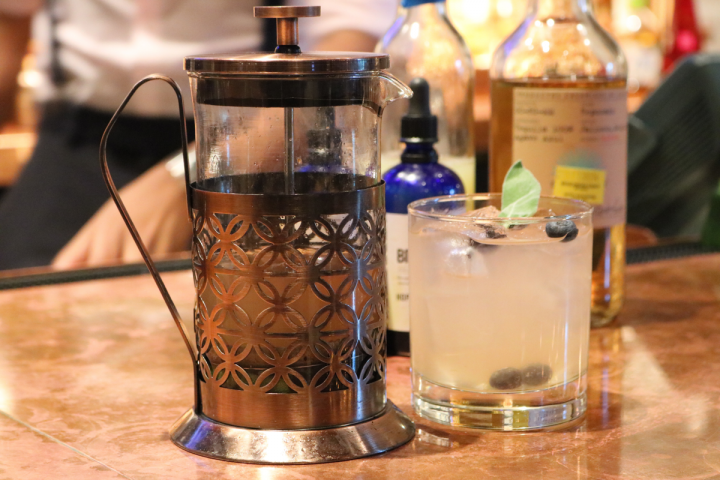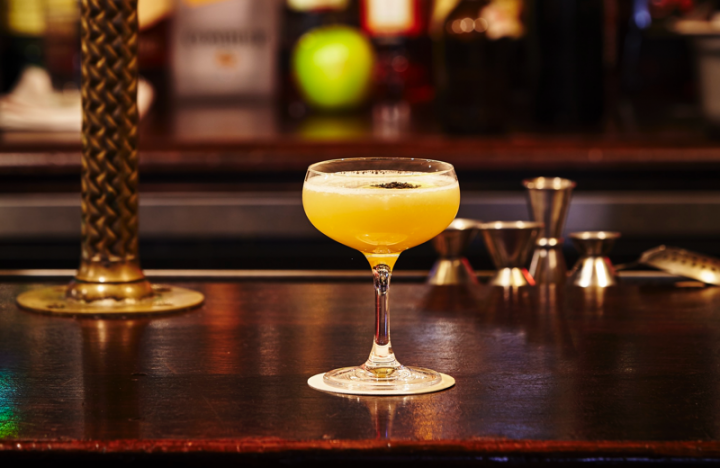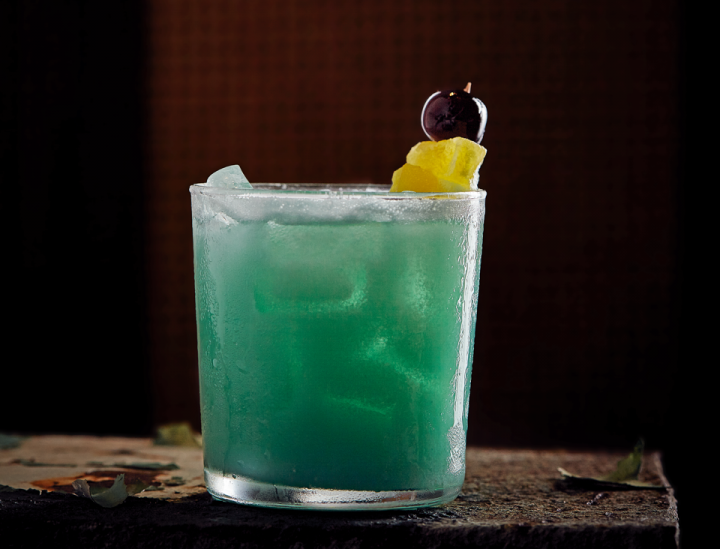
The farm-to-table restaurant is now a fixture in American dining; venues that source ingredients from local purveyors or directly from backyard gardens have become prevalent not only in major foodie cities like New York and San Francisco, but all over the country as well. It was only a matter of time before the trend made its way to the bar, says Johnny Swet, mixologist at The Skylark in New York City. “Mixologists work very closely with chefs, so it was a natural progression to see the use of locally sourced and seasonal ingredients extend into mixology,” he says.
Fernando Bambaren, bar manager and lead mixologist at Virtu Honest Craft in Scottsdale, Arizona, first noticed farm-to-bar cocktails take hold locally in 2011. “The rejuvenation of the craft cocktail scene began in New York City in the early 2000s and with that, bartenders started caring more about the ingredients in their cocktails,” Bambaren explains. “Those ideas eventually spread to Arizona—it’s been growing ever since and it doesn’t seem like it will end anytime soon.”
Peter Abbruscato, director of nightlife and entertainment at Nina’s House at the Confidante Hotel in Miami Beach, can remember an exact moment when he was introduced to the concept of cocktails featuring locally sourced ingredients. “In the summer of 2007, I visited a restaurant named Applewood in Brooklyn, New York,” Abbruscato recalls. “This was the epitome of a farm-to-table restaurant. It was owned by a husband and wife, who later purchased their own farm. They had designed an amazing cocktail program using all locally grown fresh ingredients. At the time, there was no cocktail program like it. Shortly thereafter, there was an explosion of similar cocktail programs all over Brooklyn and spreading out over the rest of New York City and now the world.”
Though a relatively new trend, making drinks with local ingredients—from fruits and herbs picked at a nearby farm to spirits distilled just down the street—is quickly becoming the norm in restaurants and bars across the country. Consumers have come to expect this level of care to be put into cocktails, and mixologists are more than happy to deliver.

Natural Flavors
A major reason behind the popularity of using locally sourced ingredients in meals and in cocktails is that consumers today are more health conscious than ever before, and they want to know exactly what they’re putting in their bodies, Bambaren says.
Swet also notes that people are eating and drinking healthier. “Consumers favor unprocessed, natural options,” he says, pointing to cocktails like his Spring Fling ($18), which features Crop Organic Cucumber vodka, St-Germain elderflower liqueur, simple syrup, fresh lemon juice, and muddled fresh green grapes and basil leaves.
“People like to see that bars are using local ingredients—something they can put their hands on and touch,” says DiSean Burns, manager of drink at Stoke restaurant in Charlotte, South Carolina. “They like familiar flavors, such as basil and berries, used in a way that showcases their freshness. Fresher is better, and people have taken note of that.” The South by Southwest ($16)—his take on a Margarita—comprises Lunazul Reposado Tequila, agave nectar, fresh lime juice, Bittermens Hopped Grapefruit bitters, Bittermens Hellfire Habanero shrub, and muddled blueberries and basil.
Consumers are drawn to cocktails that exhibit a clear attention to detail. House-made ingredients have become increasingly popular, as they both incorporate fresh flavors and reflect the personality and flair of the venue. “People are much more apt to spend $14 on a cocktail if they know you put some time and effort into creating it,” says Richard Murphy, beverage director at Kings County Imperial in Brooklyn, New York.
Michael Baldonado, bar manager at MKT Restaurant and Bar at the Four Seasons Hotel in San Francisco, uses a lot of shrubs, cordials, tinctures and bitters, all made in-house. He says these ingredients give the bar “a sense of place and style that is distinctly San Francisco,” adding that he takes pride in this handmade approach to cocktails. “I like to create my own ingredients and know where they came from and that I made them myself,” Baldonado explains. “For example, in one of my cocktails I make a passion fruit syrup that takes a few days to macerate and reduce to the flavor and consistency that I want.” The drink is called Island Fever ($16) and features Cruzan Aged Dark rum, house-made passion fruit syrup, and fresh squeezed orange and lime juices, garnished with a house-made pineapple wafer crisp that’s set ablaze with brown sugar and Everclear before serving.

Supporting Sustainability
Beyond favoring fresh ingredients for their perceived health benefits, consumers appreciate seeing bars that support the local agriculture. Abbruscato of Nina’s House says this trend has become the norm. “With their heavy focus on health and wellness, customers have really taken to local ingredients as they provide a noticeably fresh aroma and taste to cocktails, as well as allow them to understand the responsible and sustainable methods used in procuring the ingredients that they’re consuming,” he explains.
Abbruscato also notes a change in consumer expectations. “In the past, if you wanted lime juice in your cocktail, it was a neon green, sugar-based liquid, poured out of a bottle,” he recalls. “Now you would expect nothing less than freshly squeezed lime juice in your cocktail. And clearly, we have advanced from the simple juice aspect to fresh herbs and spices.” Abbruscato loves using fresh herbs in his drinks for their simple yet unique qualities. His Globetrotter cocktail ($16) blends Death’s Door gin, St-Germain, fresh basil leaves, and fresh watermelon and ginger juices, while his Spicy Nina ($16) features Caña Brava rum, fresh cilantro and jalapeño, and fresh pineapple and Honeycrisp apple juices.
Virtu Honest Craft receives shipments every week from Brother Nature Farms in Scottsdale, Arizona. “We get a variety of freshly picked herbs and fruits that I haven’t heard of or haven’t thought to use in a cocktail,” Bambaren says. “I enjoy the challenge of building a drink around new produce—it offers an opportunity for me to expand my creativity and grow as a bartender.” Bambaren’s Spring Garden ($13) comprises Arizona Distilling Co.’s Commerce gin, Turin Tuvè Bitter liqueur, Tempus Fugit Gran Classico Bitter liqueur, fresh lemon juice, simple syrup, fresh radish pods and spearmint from Brother Nature Farms, and fresh breakfast radish from another local farm called Steadfast.

Urban Farmer, a steakhouse concept with locations in Cleveland, Philadelphia, Denver and Portland, Oregon, takes locally sourced ingredients to the next level with its in-house butcher shop and partnerships with dozens of local purveyors. This homegrown feel can also be found at the bar. At Urban Farmer’s Portland venue, a rooftop apiary provides fresh honey for manager Robbie Wilson’s best-selling Farmer #3 cocktail ($12), which in addition to honey includes Ketel One vodka, St-Germain and grapefruit juice. “Fresh honey ties this drink into what we do here at Urban Farmer.” Wilson says. “I’m excited to see bartenders making their way into kitchens and becoming foragers, beekeepers and gardeners.”
At Kings County Imperial, Murphy tends a garden in the backyard and pulls from it seasonally for his cocktails. “Garnishing our drinks with our backyard mint or Thai basil is pretty awesome,” he says. “We could buy herbs at the local market, but we’d much rather grow them ourselves. The edible flowers that came out of that backyard last year were simply beautiful.”
At Farm at Carneros in Napa, California, the bar team pulls ingredients from the culinary garden just outside of the restaurant. Beverage director Zion Curiel’s Lavender & Lemon ($15) comprises Uncle Val’s Botanical gin—distilled in nearby Sonoma, California—fresh lemon juice and a house-made lavender simple syrup that incorporates lavender from the property. At Death or Glory in Delray Beach, Florida, owner Isaac Grillo’s cocktail The Green House Effect ($12) blends Afrohead Briland 7-year-old Premium Aged rum, St. George absinthe verte, simple syrup made from purple basil grown in-house, and fresh pressed lemon and grapefruit juices sourced from Bedner’s Farm Fresh Market in Boynton Beach, Florida.

Local Love
As the craft distilling boom continues, bartenders have a wide array of locally produced spirits at their fingertips. “People in Cleveland can appreciate sourcing locally and supporting and driving Ohio businesses,” says Kelly O’Connor, sales and marketing manager of Urban Farmer’s Cleveland venue. “We’ve found that people seek out our cocktail menu for options that offer ingredients from local companies, such as Cleveland Jam and Watershed Distillery in Columbus.” The Sideways ($11) blends Watershed Four Peel gin, Cleveland Jam Co.’s Rock and Roll Merlot jam, and lime juice.
“Watershed Distillery shares our ethos of sourcing local ingredients,” O’Connor adds. “Their vodka, for instance, is distilled from 100-percent Ohio corn and apples, and they also produce a nocino using walnuts from an Ohio walnut farm.” The Contadino ($14) features Wild Turkey 101 rye whiskey, Rémy Martin VSOP Cognac, Watershed Nocino walnut liqueur, Campari aperitif and Peychaud’s bitters.
Virtu Honest Craft’s Bambaren is a big fan of Arizona Distilling Co., based in nearby Tempe, Arizona. “Their Copper City Bourbon is really versatile, lending itself to various cocktail applications. It works well with so many different ingredients.” His Local Sour ($13) features the Bourbon with Giffard Crème de Pamplemousse Rose pink grapefruit liqueur, fresh lemon juice, house-made Moroccan syrup, Regans’ No. 6 orange bitters and wild za’atar from Brother Nature Farms.

“More and more consumers come in seeking local spirits from Northern Californian distilleries,” MKT’s Baldonado says. “I currently use Anchor Distilling’s Junípero gin in my take on an Aviation and St. George Spirits Botanivore gin mixed in with our house-made lemon cordial for our French 75. All of these products are made within 10 to 15 miles of us.” The Aviation ($16) comprises Junípero, Luxardo Maraschino liqueur, Tempus Fugit Spirits Liqueur de Violette—also in the Anchor Distilling portfolio—and lemon juice, while the French 75 ($16) features St. George Botanivore, house-made lemon cordial and Enza Prosecco.
“So many small, local companies are distilling their own spirits now and that’s great for our industry,” Kings County Imperial’s Murphy says. “Just the other night we had a guest who was so excited to try our Owney’s Negroni because he knew the rum is made right up the street.” The drink ($14) is served on tap and comprises Owney’s Original New York City rum, Aperol aperitif, Carpano Antica Formula sweet vermouth and Regans’ bitters.
In another draft cocktail called The Powder Keg ($13), Murphy mixes gunpowder green tea–infused Bulleit Rye whiskey with honey syrup, fresh lemon juice, egg white and an orgeat syrup that is made right in Brooklyn. “We love supporting the little guy whenever we can,” he says. “It gives me such pleasure to tell people our orgeat is made in Carroll Gardens by my friend Adam Kolesar. You don’t get much more small batch than that.”
Kolesar also provides the macadamia nut syrup in Murphy’s Coco Palms cocktail ($13), which features Denizen rum, Hiram Walker Blue Curaçao, pineapple juice and Coco Lopez cream of coconut. “We find little details like that to be really fun to share with our guests,” Murphy says. “We couldn’t be happier to support the small-batch, farm-to-bar experience.”


